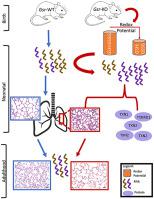Redox Biology ( IF 10.7 ) Pub Date : 2020-11-13 , DOI: 10.1016/j.redox.2020.101797 Mary E Robbins 1 , Hye-Youn Cho 2 , Jason M Hansen 3 , Joseph R Luchsinger 4 , Morgan L Locy 5 , Markus Velten 6 , Steven R Kleeberger 2 , Lynette K Rogers 7 , Trent E Tipple 8

|
Cellular antioxidants protect against hyperoxic lung injury. The role of the glutathione (GSH) system in lung development and bronchopulmonary dysplasia (BPD) pathogenesis has not been systematically investigated. The current study utilized GSH reductase-deficient (Gsr-KO) neonatal mice to test the hypothesis that early disruption of the GSH system negatively impacts lung development and hyperoxic responses. Lungs from wild-type (Gsr-WT) and Gsr-KO mice were analyzed for histopathology, developmental markers, redox indices, and transcriptome profiling at different developmental stages following exposure to room air or hyperoxia (85% O2) for up to 14 d. Lungs from Gsr-KO mice exhibited alveolar epithelial dysplasia in the embryonic and neonatal periods with relatively normal lung architecture in adulthood. GSH and its oxidized form (GSSG) were 50–70% lower at E19-PND14 in Gsr-KO lungs than in age-matched Gsr-WT. Differential gene expression between Gsr-WT and Gsr-KO lungs was analyzed at discrete developmental stages. Gsr-KO lungs exhibited downregulated cell cycle and DNA damage checkpoint genes at E19, as well as lung lipid metabolism and surfactant genes at PND5. In addition to abnormal baseline lung morphometry, Gsr-KO mice displayed a blunted response to hyperoxia. Hyperoxia caused a more robust upregulation of the lung thioredoxin system in Gsr-KO compared to Gsr-WT. Gsr-dependent, hyperoxia-responsive genes were highly associated with abnormal cytoskeleton, skeletal-muscular function, and tissue morphology at PND5. Overall, our data in Gsr-KO mice implicate the GSH system as a key regulator of lung development, cellular differentiation, and hyperoxic responses in neonatal mice.
中文翻译:

谷胱甘肽还原酶缺乏会改变新生小鼠的肺部发育和高氧反应
细胞抗氧化剂可防止高氧性肺损伤。谷胱甘肽(GSH)系统在肺发育和支气管肺发育不良(BPD)发病机制中的作用尚未得到系统研究。目前的研究利用谷胱甘肽还原酶缺陷 ( Gsr -KO) 新生小鼠来检验谷胱甘肽系统的早期破坏会对肺部发育和高氧反应产生负面影响的假设。在暴露于室内空气或高氧 (85% O 2 ) 长达 14 年后,对野生型 ( Gsr -WT) 和Gsr -KO 小鼠的肺进行组织病理学、发育标记、氧化还原指数和不同发育阶段的转录组分析。 d. Gsr -KO小鼠的肺在胚胎期和新生儿期表现出肺泡上皮发育不良,而在成年期则表现出相对正常的肺结构。 E19-PND14 时, Gsr -KO 肺中的 GSH 及其氧化形式 (GSSG) 比年龄匹配的Gsr -WT 低 50-70%。在离散的发育阶段分析了Gsr -WT 和Gsr -KO 肺之间的差异基因表达。 Gsr- KO肺在E19处表现出下调的细胞周期和DNA损伤检查点基因,以及在PND5处表现出肺脂质代谢和表面活性剂基因的下调。除了异常的基线肺形态测量外, Gsr -KO小鼠还表现出对高氧的反应迟钝。与Gsr -WT 相比,高氧导致Gsr -KO 中肺硫氧还蛋白系统更强烈的上调。 Gsr依赖性高氧反应基因与 PND5 异常细胞骨架、骨骼肌功能和组织形态高度相关。 总体而言,我们在Gsr -KO 小鼠中的数据表明 GSH 系统是新生小鼠肺发育、细胞分化和高氧反应的关键调节因子。











































 京公网安备 11010802027423号
京公网安备 11010802027423号